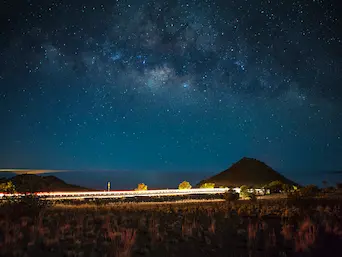Mauna Kea Mountain Stargazing
 Governments all over the world have sunk billions of dollars into scientific equipment, and it all sits on top of Mauna Kea. This massive volcano stands 13,000 feet above sea level, and the nearest big city of Los Angeles sits six hours of flying time to to the east. This leaves the sky free of light pollution. On a clear night, you can see the entire galaxy from the top of the mountain, and the multiple Mauna Kea observatories can peer deep into the cosmos.
Governments all over the world have sunk billions of dollars into scientific equipment, and it all sits on top of Mauna Kea. This massive volcano stands 13,000 feet above sea level, and the nearest big city of Los Angeles sits six hours of flying time to to the east. This leaves the sky free of light pollution. On a clear night, you can see the entire galaxy from the top of the mountain, and the multiple Mauna Kea observatories can peer deep into the cosmos.
Make sure to schedule a night of stargazing atop the massive Mauna Kea. Check the weather when you land on The Big Island, and choose a cloudy night. You’ll be able to drive up the long, slow, lazy slopes of the mountain through the fog only to burst out onto a clear summit. It’s an ethereal experience. You’ll feel like you’re on an island in the sky.
Just make sure to pack something warm for the top of the mountain. The elevation makes the air thin and cold, and it can get below freezing during the winter months. But, with a little warmth, you can bring a twilight picnic to the top of the mountain as you point at the stars. And you’ll never see so many in your life.
 On a clear day, you’ll want to get to the summit at sunset. Watching the sun dip into the ocean over the glassy volcanic rock of the dry west coast is a near-spiritual experience. It will quiet your minds, and everyone in your crew will put their cell phones away. Being enveloped in the sunset’s soft oranges, reds, pinks and deep purples will bring you all together. It’ll put you in the mindset for meaningful conversation under the starry night.
On a clear day, you’ll want to get to the summit at sunset. Watching the sun dip into the ocean over the glassy volcanic rock of the dry west coast is a near-spiritual experience. It will quiet your minds, and everyone in your crew will put their cell phones away. Being enveloped in the sunset’s soft oranges, reds, pinks and deep purples will bring you all together. It’ll put you in the mindset for meaningful conversation under the starry night.
And you can visit the top of the mountain any time of day during the winter months of January and February. With a little luck, you’ll drive to the top of the mountain to find snow. Yes, you can ski, snowboard and sled in Hawaii, but you won’t find any runs and the ground is also rather rocky. It’s better to scoop up some snow so that you can have a snowball fight on the beach.